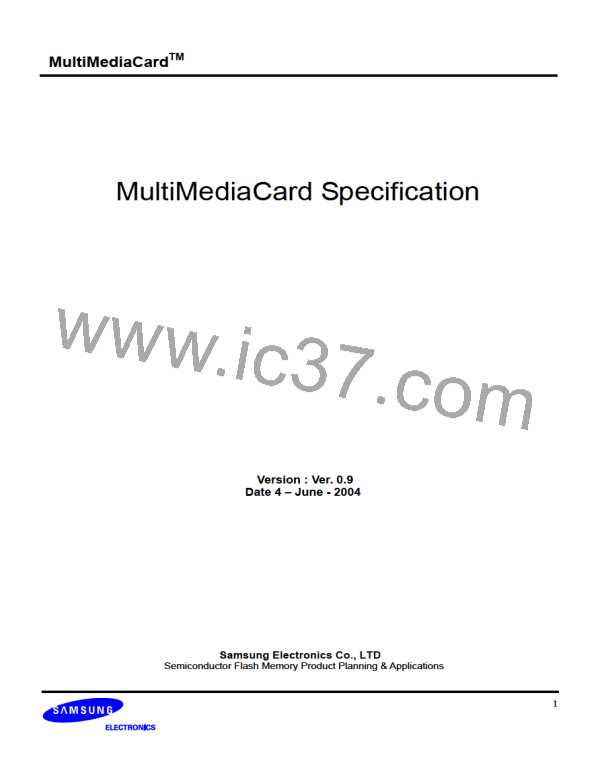MultiMediaCardTM
(generated by a push pull driver stage). The open drain driver stages on the CMD line allow the parallel
card operation during card identification. After the bus is activated the host will request the cards to send
their valid operation conditions with the command SEND_OP_COND (CMD1). Since the bus is in open
drain mode, as long as there is more than one card with operating conditions restrictions, the host gets in
the response to the CMD1 a “wired or” operation condition restrictions of those cards. The host then
must pick a common denominator for operation and notify the application that cards with out of range
parameters (from the host perspective) are connected to the bus. Incompatible cards go into Inactive
State (refer to also Chapter “Operating Voltage Range Validation”). The busy bit in the CMD1 response
can be used by a card to tell the host that it is still working on its power-up/reset procedure (e.g.
downloading the register information from memory field) and is not ready yet for communication. In this
case the host must repeat CMD1 until the busy bit is cleared. After an operating mode is established, the
host asks all cards for their unique card identification (CID) number with the broadcast command
ALL_SEND_CID (CMD2).
All not already identified cards (i.e. those which are in Ready State) simultaneously start sending their
CID numbers serially, while bit-wise monitoring their outgoing bitstream. Those cards, whose outgoing
CID bits do not match the corresponding bits on the command line in any one of the bit periods, stop
sending their CID immediately and must wait for the next identification cycle (cards stay in the Ready
State). There should be only one card which successfully sends its full CID-number to the host. This card
then goes into the Identification State. The host assigns to this card (using CMD3,
SET_RELATIVE_ADDR) a relative card address (RCA, shorter than CID), which will be used to address
the card in future communication (faster than with the CID). Once the RCA is received the card transfers
to the Standby State and does not react to further identification cycles. The card also switches the output
drivers from the open-drain to the push-pull mode in this state. The host repeats the identification
process as long as it receives a response (CID) to its identification command (CMD2). When no card
responds to this command, all cards have been identified. The time-out condition to recognize this, is
waiting for the start bit for more than 5 clock periods after sending CMD2
4.8.1 Operating Voltage Range Validation
The MultiMediaCard standards operating range validation is intended to support reduced voltage range
MultiMediaCards. The MultiMediaCard supports the range of 2.7 V to 3.6V supply voltage. So the
MultiMediaCard sends a R3 response to CMD1 which contains an OCR value of 0x80FF8000 if the
busy flag is set to “ready” or 0x00FF8000 if the busy flag is active (refer to Chapter “Responses”). By
omitting the voltage range in the command, the host can query the card stack and determine the
common voltage range before sending out-of-range cards into the Inactive State. This bus query
should be used if the host is able to select a common voltage range or if a notification to the application
of non usable cards in the stack is desired. Afterwards, the host must choose a voltage for operation
and reissue CMD1 with this condition sending incompatible cards into the Inactive State.
4.9 Data Transfer Mode
When in Standby State, both CMD and DAT lines are in the push-pull mode. As long as the content of
all CSD registers is not known, the f
clock rate is equal to the slow f
clock rate.
PushPull
OpenDrain
SEND_CSD (CMD9) allows the host to get the Card Specific Data (CSD register), e.g. ECC type, block
length, card storage capacity, maximum clock rate etc..
35

 SAMSUNG [ SAMSUNG ]
SAMSUNG [ SAMSUNG ]